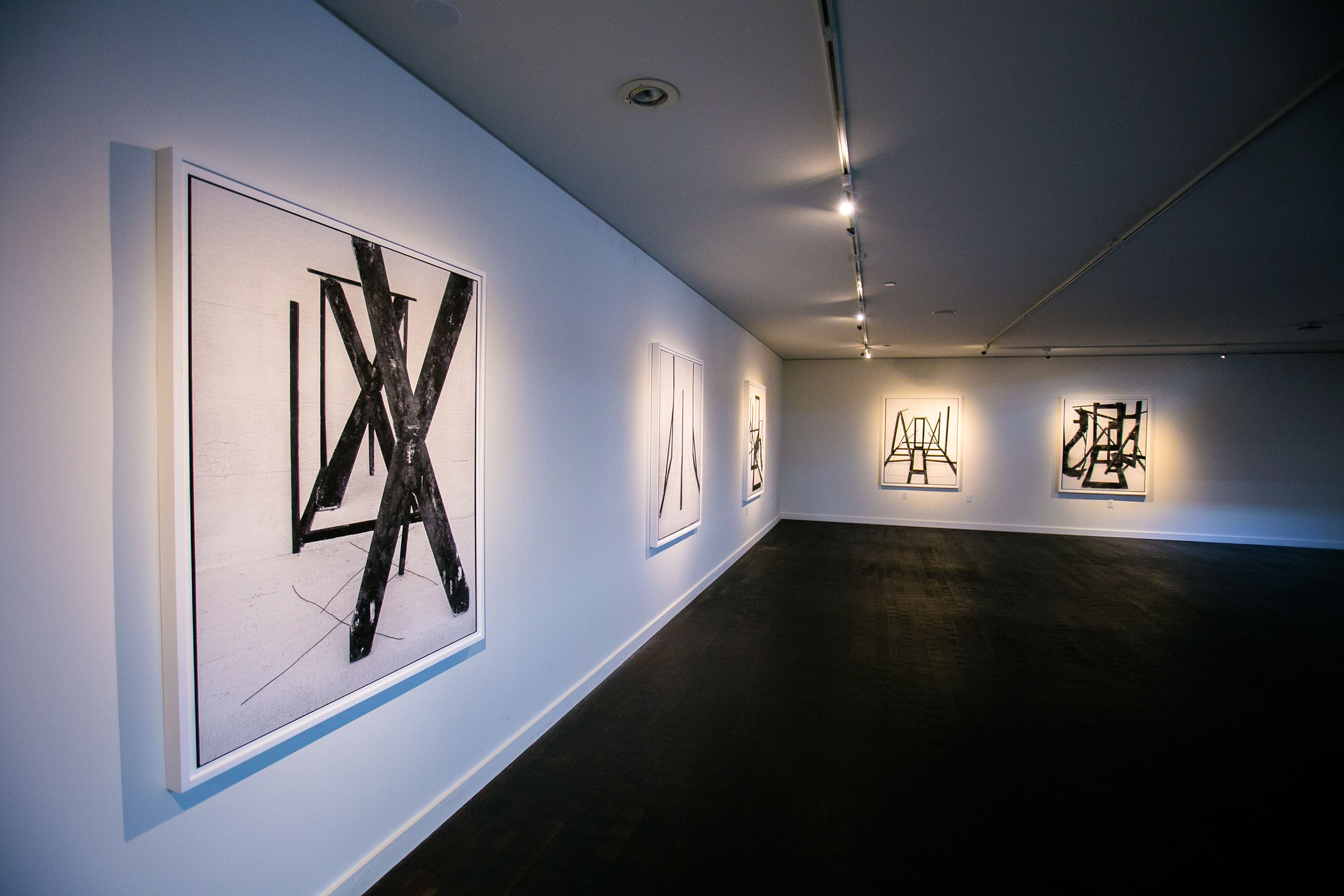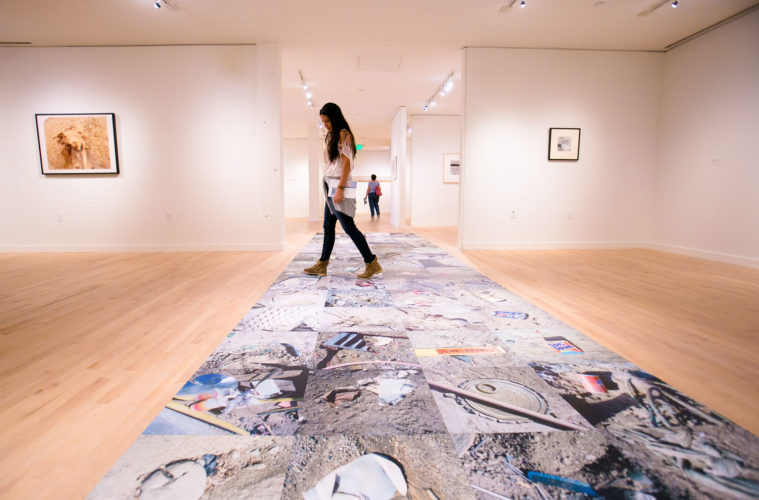The Orange County Museum of Art has been a local art destination staple in Orange County since the 1960s. The museum opened in 1962 as the Balboa Pavilion Gallery by 13 visionary women but was renamed the Newport Harbor Art Museum in 1968. In 1997, the museum was remodeled and renamed the Orange County Museum of Art (OCMA). Most recently in 2018, OCMA began a new chapter of its tenure as the leading visual arts institution in the area by moving to a new temporary home in Santa Ana, near South Coast Plaza, as it develops and builds a landmark building in the Segerstrom Center for the Arts slated to open in 2021.

Valentina Jager’s “the face the mouth the back” at OCMA. Photo by Lauren Hillary
The interim home for OCMA, dubbed OCMAEXPAND-SANTA ANA, is centrally located in the South Coast Plaza Village and although it is a humbler abode than its over-the-top future destination, a massive undertaking and landmark developing design by Thomas Mayne, its mission and execution are on-point. OCMAEXPAND, aptly named, is a physical and visual expression of a key idea. This idea of expansion is taking place all around us, especially here in Southern California. Our population is constantly expanding, and with that, our world view expands. Orange County is evolving into an inclusive and international community that thrives on and supports its many expanding communities. Therefore, it only makes sense to have its major art museum expand and evolve with it. Embracing global contemporary art production and the diverse local O.C. population, OCMAEXPAND aims to have its current and future exhibition offerings and public programs reflect the cultures, politics, and economics that are flourishing around the Pacific Rim area.
A smaller space than its previous location, OCMAEXPAND is limited in what it can do due to the nature of its existing building structure, but the museum makes great use of space and light in each of its galleries and nooks. Currently on view in OCMAEXPAND are seven independent exhibitions that converse with one another through contemporary aesthetics, minimal design and curatorial decisions. One exhibition features photography from the OCMA permanent collection for the more traditional art connoisseurs. However, the other six exhibitions highlight significant works by emerging contemporary artists from all over the Pacific region, including China, Chile, Los Angeles and Irvine. Each of the artists – Kathryn Garcia, Valentina Jager, Alan Nakagawa, Ni Youyu, Mariangeles Soto-Diaz and Rodrigo Valenzuela – all approach their art practice with the duality of looking internally at the self and externally at society, with a relevant and fascinating perspective in their methodology.

Rodrigo Valenzuela’s “American Type” at OCMA. Photo by Lauren Hillary
On the first floor of OCMAEXPAND you are forced to walk through Rodrigo Valenzuela’s “American-Type” exhibition as you make your way to the central staircase to lead you to the rest of the exhibitions. Los Angeles-based Chilean artist Valenzuela has more than a dozen photographs on view in the downstairs gallery, all of which seem like neo-abstract expressionist compositions upon first glance. Although the deeper content of these works does not come across very well, the material nature of these pieces upon closer inspection is quite interesting. They are not paintings as they may seem, but photographs of three-dimensional objects made of plaster and graphite – something that only appears to viewers after spending time looking – this perceptual play is hypnotic and enchanting.
On the second floor, there are a variety of galleries off to the sides of the central staircase, all of which are sensitive and nuanced, pulling viewers in to experience and feel their purpose and aesthetics with greater reckoning. Mariangeles Soto-Diaz has dominated the central space on the second floor with panels of bright colors, three-dimensional arrangements and matted corners for immersive play, if desired. “Everyday Grappling Operations” explores the parallel concepts used in Judo and in socio-political dynamics. Both are hinged on strategically using the opponents’ strength against them. Soto-Diaz studied and practiced Judo throughout her childhood and now again as she is an adult. She also offers the opportunity for viewers to immerse themselves in a Judo-like challenge, with floor and wall mats in some of the corners of this exhibition, you are invited to grapple with something challenging for yourself physically or mentally. She has also asked for interested participants to report their #everydaygrapplingoperations on social media through tags and hashtags.
The outlying exhibitions surround Soto-Diaz’s “Grappling Operations” in OCMAEXPAND and seem to occupy similar areas of thought and feeling, although the expression is very different for every artist. Ni Youyu creates “Dust Paintings” that are gorgeous and ethereal expressions acting as exact replicas of images of the galaxy, only made with chalk dust and meticulous delicacy.

Artist Mariángeles Soto-Díaz takes visitors through “Everyday Grappling Operations.” Photo by Lauren Hillary.
Alan Nakagawa’s extraordinary interactive sound installation “Peace Resonance: Hiroshima/Wendover as a Room” provides beds of metal that vibrate with sound. Visitors are asked to lay down on the metal beds and immerse themselves in the sounds of the two historical sites – Hiroshima Atomic Dome in present-day Japan and the Wendover Hangar in Utah, where the Enola Gay B-29 bomber plane departed in 1945 to drop atomic bombs on Hiroshima and Nagasaki – reminding visitors of the innate connection between them and our existence in spite of them.
Valentina Jager’s tissue paper installation, “the face the mouth the back,” also has a political angle although it does not come across as strongly as Nakagawa’s. Jager’s installation does however evoke a poetic and ephemeral experience that is hypnotic and otherworldly. Her delicate tissue paper collages hang in a variety of areas in the gallery space, swaying with every breath or step taken in the nearby vicinity. Much like beings, these sensitive paper tapestries are affected by everything around them, absorbing the elements into themselves, but remain intact unless physically harmed. As fragile as they are, they remain strong and unyielding in the face of chaos.
Kathryn Garcia’s “gone, gone way beyond” is a more spiritual exploration through installation and art objects. Her work is rooted in historic and spiritual feminist archetypes that have informed contemporary human consciousness. Her drawings and sculptures are poignant and attractive abstract expressions that feel entrenched in ancient spirituality, but her installation feels a bit too contemporary. Inspired by the ancient burial mounds and places of worship, Garcia invites visitors to enter a meditation pyramid surrounded by small metallic objects placed specifically for meditative purposes. Although minimal in design and interactive, the installation doesn’t quite resonate with the history and significance that informs it. The works are gorgeously put together in object-based set-ups, but cannot live without the wall-text explaining the concepts that advise her creations.
Regardless of whether the work on view at OCMAEXPAND is the ideal work for every aesthetic, the quality of work on display is compelling and important. Not all art discourse is easy, and because of that difficulty, some institutions shy away from the conversations inherent in complex contemporary art. However, the new OCMAEXPAND is a bold art space that, if they follow their mission, will lead the way for contemporary Orange County art and force other artistic institutions in the area to step up their art offerings to reflect the evolving themes and populations, and showcase great works of contemporary art.
Advertising disclosure: We may receive compensation for some of the links in our stories. Thank you for supporting Irvine Weekly and our advertisers.

